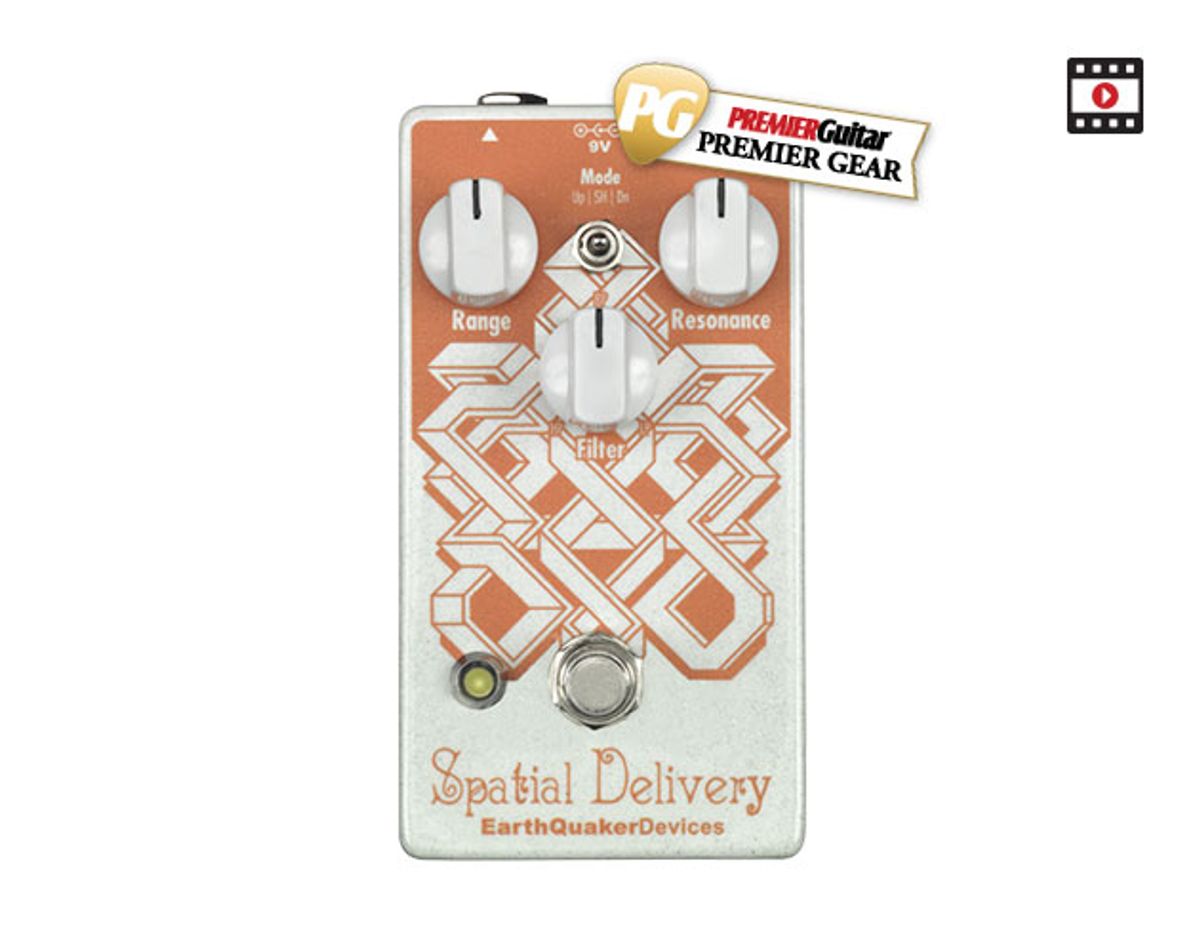Thanks to its clever multi-mode switch, this auto-filter will have you creating exciting new sounds way faster than more complex filters.
Voltage-controlled envelope filter pedals seem to be en vogue again. This time, though, they’re not just for neo-funkateers. Yeah, it can be tough to plug into one and not go all P-Funk. But wily guitarists have demonstrated that when you mate resonant filters with fuzzes and other modern noisemakers, it’s possible to move well beyond the usual clean-toned quackety-quack.
But really, most of today’s envelope filters aren’t that far removed from Mike Beigel’s 1972 Mu-Tron III, the first voltage-triggered filter effect. Nowadays you can choose from many Mu-Tron clones and spin-offs, including models from Beigel’s own Mu-FX line. Given that, it’s the little twists and variations that make a modern auto-filter compelling. And compelling is certainly the word for the new Spatial Delivery envelope filter from Earthquaker Devices.
Deceptively Simple
The Spatial Delivery layout seems simple. There are only three knobs: range (sensitivity), resonance (feedback), and filter (the cutoff frequency). There’s also a small toggle with three settings (up, down, and sample and hold). The effect lives in a standard 125B-sized enclosure with top-mounted plastic jacks and a silent relay switch. Old-school through-hole components populate the tidy circuit board. Spatial Delivery runs on standard 9V power. There’s no battery option.
Spatial Delivery offers a wealth of resonant-filter sounds despite relatively few knobs. Much of this is due to a control the pedal doesn’t have: a filter-mode selector. Most envelope filters have a switch to choose between low-pass, high-pass, and (maybe) band-pass filtering. But here, the filter control fades continuously between low-pass, band-pass, and high-pass, which means a huge range of filter variations are accessible via a single control.
Ratings
Pros:
Great tones. Easy and intuitive to use. Fair price.
Cons:
None.
Tones:
Ease of Use:
Build/Design:
Value:
Street:
$195
EarthQuaker Devices Spatial Delivery
earthquakerdevices.com
Thanks to the multi-mode filter knob, operation is easy and intuitive. Just tune the response with the range control, spin the magic filter knob, and sharpen or soften the filter edge with the resonance knob. I can’t recall encountering an envelope filter that coughs up so many usable sounds quite so quickly.
Resonant Evil
With the toggle set to filter-up mode, positioning the knobs near noon yields the expected Jerry Garcia/Stevie Wonder quacking. These tones are tactile and pleasantly “chewy.” Dialing back the sensitivity for lower-than-usual filter-cutoff yields darkly brassy timbres—a nice variation on the usual effect.
In filter-down mode, tones are fat at the moment of attack before becoming thin and crispy. This setting unleashes all manner of “gulping” effects, from comical popcorn sounds to twangy, sitar-like timbres.
With the toggle set to sample and hold, random frequencies create rhythmic burbling that recalls a “computer” sound effect from a 1960s sci-fi flick. In this mode, the range knob controls the speed. So while there’s no tap-tempo control, it’s not hard to create roughly tempo-synched flickers and burbles. In all modes, the range (sensitivity) control is perfectly calibrated. It’s easy to dial in just the right response to suit your touch.
It’s interesting to compare Spatial Delivery’s approach to that of another recent envelope filter, 3Leaf’s Wonderlove, reviewed in our July ’16 issue. The pricier Wonderlove is packed to the gills with clever options, from a wet/dry mix to an onboard effect loop. It has 11 controls compared to Spatial Delivery’s four. Which design is best? The answer probably depends on whether you prefer an interface with maximum options, or one with maximum simplicity. (Both pedals sound great, and they both earned our Premier Gear award.
The Verdict
Don’t let Spatial Delivery’s simple layout fool you—this envelope filter is capable of countless cool and usable tones. Thanks to the clever multi-mode filter, you may well create exciting new sounds in a fraction of the time required by a more complex filter effect. The sound quality is superb. The versatile controls are beautifully calibrated. And the price is right for a handmade, U.S.-built pedal.
Watch the Review Demo:


